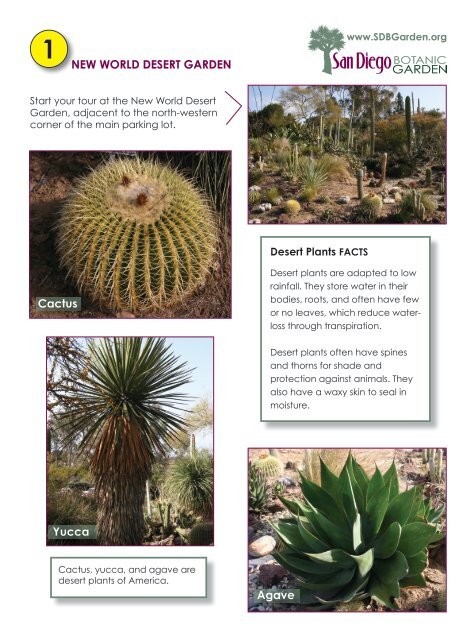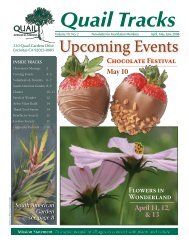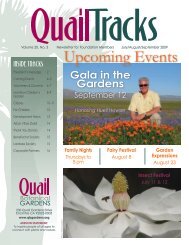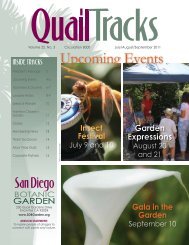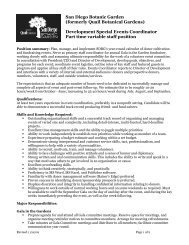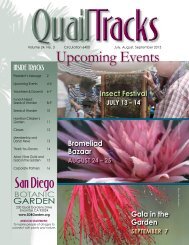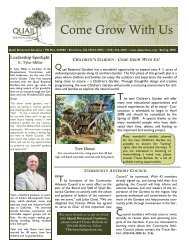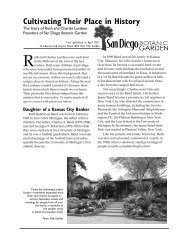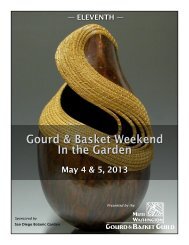NEW WORLD DESERT GARDEN Cactus Yucca Agave - San Diego ...
NEW WORLD DESERT GARDEN Cactus Yucca Agave - San Diego ...
NEW WORLD DESERT GARDEN Cactus Yucca Agave - San Diego ...
You also want an ePaper? Increase the reach of your titles
YUMPU automatically turns print PDFs into web optimized ePapers that Google loves.
1<br />
<strong>NEW</strong> <strong>WORLD</strong> <strong>DESERT</strong> <strong>GARDEN</strong><br />
www.SDBGarden.org<br />
Start your tour at the New World Desert<br />
Garden, adjacent to the north-western<br />
corner of the main parking lot.<br />
Desert Plants FACTS<br />
<strong>Cactus</strong><br />
Desert plants are adapted to low<br />
rainfall. They store water in their<br />
bodies, roots, and often have few<br />
or no leaves, which reduce waterloss<br />
through transpiration.<br />
Desert plants often have spines<br />
and thorns for shade and<br />
protection against animals. They<br />
also have a waxy skin to seal in<br />
moisture.<br />
<strong>Yucca</strong><br />
<strong>Cactus</strong>, yucca, and agave are<br />
desert plants of America.<br />
<strong>Agave</strong>
2<br />
BAMBOO <strong>GARDEN</strong><br />
www.SDBGarden.org<br />
Walk up the slope and turn left at the driveway. Go down the hill and enter the<br />
Bamboo Garden on your left side.<br />
Try to find the Giant Bamboo<br />
right at the entrance to the<br />
Bamboo Garden.<br />
Bamboo FACT<br />
Bamboo are giant members<br />
of the grass family. There are<br />
more than 1000 species of<br />
bamboo.<br />
Bamboo provides food,<br />
paper-pulp, construction and<br />
decorative material. It is used<br />
in landscaping, and even<br />
offers religious and artistic<br />
inspiration.<br />
Beechey Bamboo FACT<br />
The Giant Pandas at the<br />
<strong>San</strong> <strong>Diego</strong> Zoo like to eat the<br />
leaves and canes of this large<br />
bamboo.<br />
Bamboo comes in many different sizes and colors.<br />
Explore the Bamboo Garden and try to find the….<br />
Painted Bamboo<br />
Black Bamboo
3<br />
POND IN THE BAMBOO <strong>GARDEN</strong><br />
www.SDBGarden.org<br />
Turn south and visit the pond in the Bamboo Garden.<br />
Can you find a bull frog on the edge of the pond, or little guppies hiding in the algae?<br />
Do you see other animals that live around the pond?
4<br />
SUBTROPICAL FRUIT <strong>GARDEN</strong><br />
www.SDBGarden.org<br />
From the Bamboo Garden, turn north<br />
and cross the driveway to enter the<br />
Subtropical Fruit Garden.<br />
The trellis at the entrance to the fruit garden<br />
is overgrown with a dragon fruit plant.<br />
The flesh of the fruit of this cactus plant can<br />
be eaten raw.<br />
Citrus FACTS<br />
Pink Lemonade<br />
Lemon<br />
Sometimes you can find flowers and fruits<br />
on a tree at the same time. Fruits develop<br />
out of flowers.<br />
The ancestors of citrus came<br />
from Southeast Asia, China,<br />
and Malaysia, probably more<br />
than a thousand years ago.<br />
Christopher Columbus brought<br />
citrus plants to America.<br />
Oranges, lemons, limes,<br />
tangerines and grapefruits are<br />
all examples of citrus plants.<br />
Cocktail<br />
Grapefruit<br />
Fig FACTS<br />
Fig trees are one of the first fruits cultivated<br />
by humans. Figs can be eaten raw or dried.<br />
Figs<br />
In 1769, Figs were introduced into California<br />
at Mission <strong>San</strong> <strong>Diego</strong> de Alcala, about<br />
25 miles south of here.
4<br />
SUBTROPICAL FRUIT <strong>GARDEN</strong> continued<br />
www.SDBGarden.org<br />
Avocado FACTS<br />
Avocados are native to the<br />
region from southern Mexico to<br />
northern South America.<br />
Avocado<br />
Incas and Aztecs were growing<br />
avocados before Europeans<br />
arrived.<br />
Rose Family FACTS<br />
Many edible fruits come from the Rose Family.<br />
These include apples, apricots, plums, cherries,<br />
peaches, pears, raspberries, strawberries, and<br />
almonds.<br />
Plants of the Rose Family have a worldwide<br />
range, but are most diverse in the northern<br />
hemisphere.<br />
Peach tree and flower
5<br />
Banana Blvd<br />
www.SDBGarden.org<br />
Head east and visit the “Banana Blvd”<br />
Try to find banana fruits<br />
Banana Facts<br />
Banana plants are native<br />
to tropical Southeast Asia,<br />
and are likely to have been<br />
first domesticated in Papua<br />
New Guinea. Today, they are<br />
cultivated throughout the<br />
tropics. They are grown in at<br />
least 107 countries, primarily for<br />
their fruit.<br />
Bananas are non-woody plants<br />
and are best described as an<br />
herb – there is no such thing as<br />
a “banana tree”.<br />
Banana fruit develop from<br />
the banana heart, in a large<br />
hanging cluster, made up of tiers<br />
(called hands) with up to 20 fruit<br />
to a tier.
6<br />
HERB <strong>GARDEN</strong><br />
www.SDBGarden.org<br />
From the Banana Boulevard head east and cross the driveway to visit the<br />
Herb Garden.<br />
Herb FACTS<br />
An herb is a plant that is valued for<br />
flavor, scent, medicinal or other qualities<br />
other than its food value. Herbs are<br />
used in cooking, as medicines, and for<br />
spiritual purposes.<br />
Examples of culinary herbs are thyme,<br />
lavender, rosemary, parsley, dill, basil,<br />
and cilantro.<br />
Explore the herb garden and try to find<br />
a couple of different herbs. Rub a rosemary<br />
and lavender leaf between your fingers<br />
and smell their fragrance.<br />
Examples of medicinal herbs are<br />
Echinacea, foxglove, chamomile,<br />
ginger, and peppermint.<br />
Rosemary<br />
Parsley<br />
Lavender<br />
Chives
7<br />
OVERLOOK – COASTAL SAGE SCRUB<br />
www.SDBGarden.org<br />
From the Herb Garden turn north to visit the Coastal Sage Scrub and Overlook.<br />
Coastal Sage Scrub<br />
While you cross the walkway<br />
you will be above a remnant<br />
of California’s Coastal Sage<br />
Scrub. The Coastal Sage Scrub<br />
contains plants and animals<br />
originally found nowhere else in<br />
the world.<br />
It is characterized by lowgrowing<br />
drought-resistant<br />
shrubs adapted our climate.<br />
Characteristic plants include<br />
California sagebrush, black<br />
sage, white sage, California<br />
buckwheat, coast brittle-bush,<br />
golden yarrow, lemonade<br />
berry, along with grasses, and<br />
in some places, cacti and<br />
succulents.<br />
Chamise
8<br />
RAIN FOREST AND WATERFALL<br />
www.SDBGarden.org<br />
The upper pond of the water fall can be seen<br />
at the entrance to the overlook walkway.<br />
Rainforest FACTS<br />
Tropical rainforests are forests with<br />
tall trees, warm climate, and lots of<br />
rain. In some rainforests it rains more<br />
than one inch every day!<br />
Rainforests are found in Africa, Asia,<br />
Australia, and Central and South<br />
America. The largest rainforest in the<br />
world is the Amazon rainforest.<br />
Tropical rainforests support the<br />
greatest diversity of living organisms<br />
on Earth. Although they cover<br />
less than 2% of Earth’s surface,<br />
rainforests house more than 50%<br />
of the plants and animals on Earth.<br />
Many well-known animals including<br />
monkeys, frogs, lizards, birds, snakes,<br />
sloths, and small cats are found in<br />
the canopy. Many of the largest<br />
rainforest animals are found on the<br />
forest floor. Some of these include<br />
elephant, tapir, and the jaguar.<br />
To visit the middle ponds of the<br />
water fall, cross the herb garden<br />
and go down the stairs.<br />
Chamise<br />
Plants that grow on the rainforest<br />
floor usually have large leaves to<br />
catch as much light as possible.
8<br />
RAIN FOREST AND WATERFALL continued<br />
www.SDBGarden.org<br />
Turn to the left and walk around the lawn<br />
area and Gazebo to reach the water fall.<br />
Explore the lush rainforest surrounding<br />
the waterfall.<br />
Epiphytes FACTS<br />
Competition at ground level for light and food has lead<br />
to the evolution of plants which live on the branches<br />
of other plants, or even strangle large trees to fight for<br />
survival.<br />
The aerial plants often gather nourishment from<br />
the air itself using ‘air roots’. The humidity of the<br />
rainforest encourages such adaptations which would<br />
be impossible in other forests with their much drier<br />
conditions.<br />
Epiphytes grow everywhere but can be found mainly on<br />
the branches, trunks, and even the leaves of trees.<br />
The name ‘epiphyte’ comes from the Greek word ‘epi’<br />
meaning ‘upon’ and ‘phyton’ meaning ‘plant’.<br />
Different types of epiphytes may grow on the same tree,<br />
including orchids, cacti, bromeliads, aroids, lichens,<br />
mosses, and ferns. They begin their life in the canopy<br />
from seeds or spores transported there by birds or winds.
8<br />
RAIN FOREST AND WATERFALL<br />
www.SDBGarden.org<br />
To visit the lower ponds of the waterfall go down the stairs.<br />
Bromeliad FACTS<br />
Bromeliads are related to the pineapple<br />
family. Their thick, waxy leaves form a bowl<br />
shape in the center for catching rainwater.<br />
Some bromeliads can hold several gallons<br />
of water and are miniature ecosystems in<br />
themselves providing homes for several<br />
creatures including frogs and their tadpoles,<br />
salamanders, snails, and beetles.<br />
Having the stream on your left, continue south on this path.<br />
The stream ends in a pond on your left hand side.<br />
Note the papyrus plants growing inside this pond.<br />
Pritchardia Palm<br />
Philodendron<br />
Papyrus FACTS<br />
Papyrus<br />
Papyrus plants belong to a family of flowering plants known as sedges.<br />
The ancient Egyptians produced a thick paper-like material from the pith<br />
of the papyrus plant which was once abundant in the Nile Delta of Egypt.
9<br />
Cork Oak Trees<br />
www.SDBGarden.org<br />
From the papyrus pond continue south on this path<br />
until you reach the driveway. Turn right at the<br />
driveway and walk up the slope.<br />
To visit the Cork Oaks turn left into the<br />
narrow walkway across from the Lawn Area.<br />
Cork Oak Tree FACTS<br />
Cork Oak Tree<br />
Cork oak is a type of<br />
oak tree native to the<br />
Mediterranean. The tree has<br />
adapted to problems of fire<br />
by growing thick bark as a<br />
protective layer. This cork<br />
layer has many industrial<br />
uses. Cork oak trees are not<br />
felled, the bark is stripped by<br />
hand, using a special axe.<br />
This layer slowly re-grows,<br />
creating a sustainable crop.<br />
Trees are harvested every<br />
9 to 12 years. A tree will be<br />
approximately 50 years old<br />
before its bark can be used<br />
for a wine stopper and may<br />
live to be 200 years old.<br />
Can you find some acorns on the ground?<br />
They are the seeds of the oak tree.
10<br />
CANARY ISLANDS <strong>GARDEN</strong><br />
www.SDBGarden.org<br />
From the cork oaks, continue on the same path and the<br />
Canary Island Garden will be on your left.<br />
Dragon Tree FACTS<br />
Dracaena draco, the Canary<br />
Islands Dragon Tree is native<br />
to the Canary Islands, Cape<br />
Verde, Madeira, and western<br />
Morocco.<br />
Dragon trees do not display<br />
annual rings, so the age can<br />
only be estimated by the<br />
number of branches. Some<br />
Dragon trees are believed to<br />
be up to 650 years old.<br />
Try to find traces of<br />
the Dragon Tree’s<br />
red sap on the stem<br />
of the trees, or find<br />
some old leaves<br />
on the ground. The<br />
bases of the leaves<br />
are also stained red<br />
by the resin.<br />
When the bark or leaves are<br />
cut they secrete a reddish<br />
resin, which is also known as<br />
Dragon’s blood. Resin is used to<br />
stain wood, such as for violins.<br />
This concludes our self guided tour through <strong>San</strong> <strong>Diego</strong> Botanic Garden.<br />
The path that you are on will bring you back to the parking lot.


